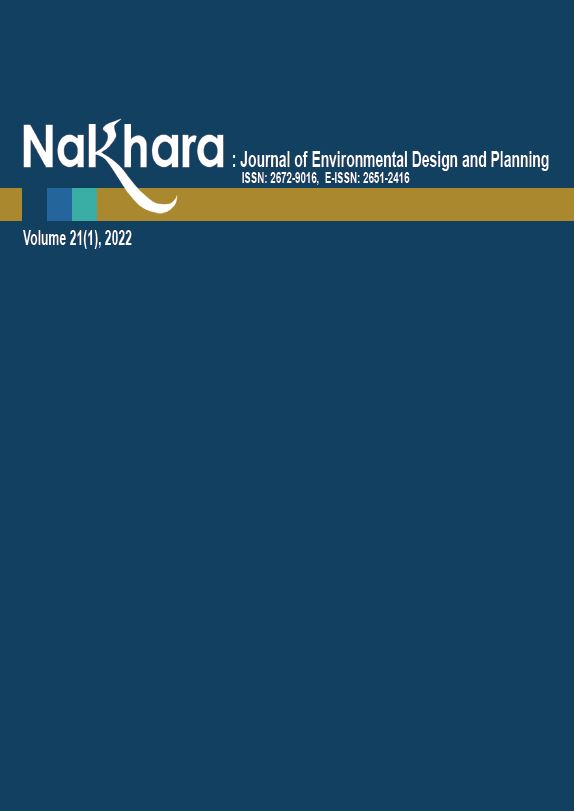The Development of Modern Landscape Architecture in Thailand
Main Article Content
Abstract
The profession of landscape architecture has been firmly established in Thailand and has continued to flourish for over 40 years. Throughout this time, landscape architecture has made important contributions in improving environments, the people’s quality of life, and the aesthetics of Thailand’s cities and communities. This research discusses the development of the landscape architecture profession and design concepts in Thailand from the beginning to present to understand how landscape architecture has been cultivated through the processes of adaptation and appropriation.
The major contents of this research were obtained from the analysis of interviews conducted with 20 practitioners of landscape architecture firms in Thailand. The topics of discussion include multiple factors affecting the concepts, styles, and typologies of landscape architectural design.
The results show that landscape architecture in Thailand has developed in parallel with global design trends since the beginning of this profession. However, contextual factors, particularly socio-economic, political, and environmental issues, also affected the variation of project types and detailed designs. These trends and factors help foster the richness of landscape architecture in Thailand.
Article Details

This work is licensed under a Creative Commons Attribution-NonCommercial-NoDerivatives 4.0 International License.
References
Antonetti, N. (2012). William Andrews Nestfield and the origins of the landscape architect. Landscape History, 33(1), 69–86.
Baird, C. T., & Szczygiel, B. (2007). Sociology of professions: The evolution of landscape architecture in the United States. Landscape Review, 12(1), 3–25.
Berrizbeitia, A. (2016). Design: On the (Continuing) Uses of Arbitrary. In J. D. Hunt (Ed.), A Cultural History of Gardens in the Modern Age (pp. 13–36). Bloomsbury Acedemic.
Boonkham, D. (1995). Kān patibat wichāchīp phūmi sathāpattayakam [Professional Practice in Landscape Architecture]. Chulalongkorn University Press.
Boonyamanop, C. (1964). Kānčhat sūan (khambanyāi kān ʻoprom wichākān plūk læ toktǣng tonmai samrap prachāchon run thī hok khrang thī nưng / 2507) [Garden Design (A lecture on the growing and pruning trees for public)]. A Publication in Memory of Mrs.Tess Praneeprachachon. Thai Samphan Printing House.
Deming, M. E., & Swaffield, S. (2011). Landscape Architecture Research: Inquiry, Strategy, Design. John Wiley & Sons Inc., 2011.
Holden, R. (2008, October 17-18). The UK experience, the development of the landscape architecture profession in the United Kingdom [Unpublished]. International Landscape Architecture Symposium 2008: The Future of Landscape Architecture in Mediterranean Countries: Identity and Challenges, Istanbul Technical University.
Leightner, J. E. (2007). Thailand’s financial crisis: Its causes, consequences, and implications. Journal of Economic Issues, 41(1), 61–76.
Mildawani, I. (2015). The Emergence of Landscape Architecture in Different Contexts: Factors Influencing the Shaping of the Profession in Australia and Indonesia [Doctoral dissertation, Curtin University, Australia]. https://espace.curtin.edu.au/handle/20.500.11937/2064
Moen, B. (2014). Professional development in landscape architecture: professionalization, geographic trends, and research consumption [Master’s thesis, University of Illinois at Urbana-Champaign].
Newman, P. (2014). Biophilic urbanism: A case study on Singapore. Australian Planner, 51(1), 47–65. https://doi.org/10.1080/07293682.2013.790832
Pike, J. (1979). The development of the landscape architecture profession in Australia. Landscape Australia, 1(2), 85-87.
Roe, M. (2007). British landscape architecture: History and education. Urban Space Design, 20(5), 109-117.
Saniga, A. (2013). Making landscape architecture in Australia. University of New South Wales Press.
Shuib, K. B. (2013). Landscape architects professional code ofethics. In O. M. Tahir (Ed.), Landscape Architectural Professional Practice Course. Institute of Landscape Architects Malaysia (ILAM).
Simo, M. (1999). 100 years of landscape architecture some patterns of a century. ASLA Press.
Thai Association of Landscape Architects. (2009). The passage to Thai landscape architecture. Li-Zenn Publishin
Thompson, I. H. (2014). Landscape architecture: A very short introduction. Oxford University Press.
Tiptus, P., Sirithanawat, C. & Issarathumnoon, W. (2006). Sathāpattayakam lang phō̜.sō̜. sō̜ngphanhārō̜isīsip: wikrittakān læ thāng lư̄ak khō̜ng sathāpanik [Thai Architecture after 1997: Crisis and Alternatives for Thai Architects]. Ratchadaphiseksomphot Endowment Fund, Chulalongkorn University.
Treib, M. (2015). Complexity and spectacle: Three American landscapes of the 1980s. Journal of Landscape Architecture 10, no. 3, 6–19. https://doi.org/10.1080/18626033.2015.1094899
Treib, M., & Imbert, D. (1997). Garrett eckbo: Modern landscapes for living. University of California Press.
Waldheim, C. (2016). Landscape as urbanism: A general theory. Princeton University Press.
Wijaya, M. (2003). Tropical garden design. Periplus.

